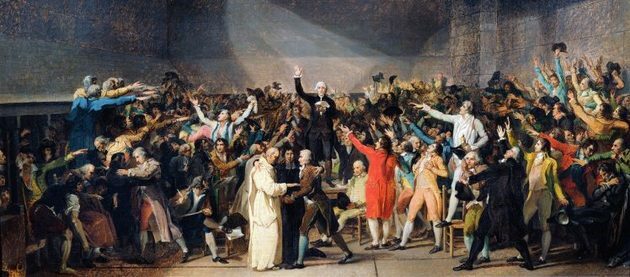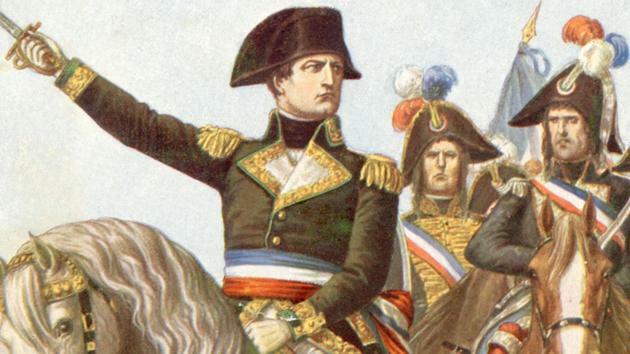THE French Revolution, which began on June 17, 1789, was a movement driven by the bourgeoisie and had the participation of peasants and urban classes who lived in poverty.
On July 14, 1789, the Parisians took the Bastille prison, triggering profound changes in the French government.
Historical context
At the end of the 18th century, France was an agrarian country, with production structured on the feudal model. This meant that there were taxes and licenses that were only valid for certain regions. Political power was concentrated in the king and a small number of aides.
Therefore, for the bourgeoisie and part of the nobility, it was necessary to end the absolute power of King Louis XVI.
Meanwhile, on the other side of the English Channel, England, its rival, was developing the process of the Industrial Revolution.
Phases of the French Revolution
For study purposes, the French Revolution is divided into three phases:
- Constitutional Monarchy (1789-1792);
- National Convention (1792-1795);
- Directory (1795-1799).
Causes of the French Revolution
The French bourgeoisie, concerned with developing industry in the country, wanted to end the barriers that restricted the freedom of international trade. In this way, it was necessary to adopt in France, according to the bourgeoisie, economic liberalism.
The bourgeoisie also demanded the guarantee of their political rights, as they supported the state, since the clergy and the nobility were free to pay taxes.
Despite being the economically dominant social class, its political and legal position was limited.
Enlightenment
O enlightenment it spread among the bourgeois and propelled the beginning of the French Revolution.
This intellectual movement made harsh criticisms of mercantilist economic practices, absolutism, and the rights granted to the clergy and the nobility.
Its best known authors were Voltaire, Montesquieu, Rousseau, Diderot and Adam Smith.
Economical and political crisis
The critical economic situation, on the eve of the 1789 revolution, demanded reforms, but generated a political crisis. This was aggravated when ministers suggested that the nobility and clergy should pay taxes.
Pressured by the situation, King Louis XVI summons the States General, an assembly formed by the three branches of French society:
- First State - composed of the clergy;
- Second State - formed by the nobility;
- third estate - composed of all those who did not belong to the First or Second Estate, in which the bourgeoisie stood out.
The Third Estate, more numerous, pressed for the votes of the laws to be individual and not by the State. Only then, the Third Estate could pass rules that favored them.
However, the First and Second States rejected this proposal and voting continued to be carried out by the State.
In this way, gathered at the Palace of Versailles, the Third Estate and part of the First Estate (lower clergy) separate from the Assembly. Then, they declare themselves the legitimate representatives of the nation, forming the National Constituent Assembly and swearing to remain together until the Constitution is ready.

Constitutional Monarchy (1789-1792)
On August 26, 1789, the Declaration of the Rights of Man and Citizen was approved by the Assembly.
This Declaration ensured the principles of liberty, equality, fraternity ("Release,égalite,fraternity” - motto of the Revolution), in addition to the right to property.
King Louis XVI's refusal to approve the Declaration provoked new popular demonstrations. The assets of the clergy were confiscated and many priests and nobles fled to other countries. Instability in France was great.
The Constitution was completed in September 1791. Among the articles we can highlight:
- the government was transformed into constitutional monarchy;
- executive power would rest with the king, limited by the legislature, constituted by the Assembly;
- deputies would serve a two-year term;
- instituted the census vote (only voters with a minimum income);
- the privileges and the old social orders were suppressed;
- the abolition of serfdom and the nationalization of ecclesiastical goods were confirmed;
- slavery was maintained in the colonies.
National Convention (1792-1795)
The Legislative Assembly was replaced, through universal male suffrage, by the National Convention, which abolished monarchy and established the Republic. Jacobins were the majority in this new parliament.
King Louis XVI was tried and found guilty of treason, being sentenced to death by guillotine and executed in January 1793. Months later, Queen Marie Antoinette would have the same fate.
Internally, the divergent opinions on how the revolution should be conducted began to provoke divisions among the revolutionaries themselves. There were basically two groups:
You Girondin - representatives of the upper bourgeoisie, defending moderate positions and the constitutional monarchy.
For their part, the Jacobins - representatives of the middle and petty bourgeoisie, constituted the most radical party, under the leadership of Maximilien Robespierre. They wanted the installation of a republic and a popular government.
The Terror (1793-1794)
Within the period of the National Convention there is an extremely violent year, in which people suspected of being counterrevolutionaries were condemned to the guillotine. This period was known as "terror".
This was possible thanks to the approval of the Suspects Law that authorized the arrest and death of those considered anti-revolutionaries. At the same time, churches were closed and religious were forced to leave their convents. Those who refused to swear an oath on the Civil Constitution of the Clergy were executed. In addition to the guillotine, suspects were drowned in the Loire River.
The Jacobin dictatorship introduced new features in the Constitution such as:
- universal and non-census vote;
- end of slavery in the colonies;
- freezing the prices of basic products such as wheat;
- institution of the Revolutionary Court to try the enemies of the Revolution.
The executions became a popular spectacle as they took place several times a day in a public act. For the dictators they were a fair way to end their enemies, but this attitude caused fear in the population that turned against Robespierre and accused him of tyranny.
In this sequence, after being detained, Robespierre was executed and this fact became known as the “Blow of the 9 Thermidor”, in 1794.

Directory (1794-1799)
The Directory phase lasts five years and is characterized by the rise of the upper bourgeoisie, the Girondins, to power. It receives this name, as there were five directors who governed France.
Enemies of the Jacobins, their first act is to revoke all the measures they had taken under their legislation. However, the situation was delicate. The Girondins attracted the public's antipathy by overturning the price freeze.
Several countries, such as England and the Austrian Empire, threatened to invade France in order to contain revolutionary ideals. Finally, the nobility themselves and the royal family in exile sought to organize themselves to restore the throne.
Faced with this situation, the Directory resorts to the Army, in the figure of the young general Napoleon Bonaparte to contain the enemies' tempers.
In this way, Bonaparte gives a hit - the 18th Brumaire - where he established the Consulate, a more centralized government that would bring peace to the country for a few years.
Consequences of the French Revolution

In ten years, from 1789 to 1799, France underwent profound political, social and economic changes.
THE aristocracy the Old Regime lost its privileges, freeing the peasants from the ties that bound them to the nobles and the clergy. The feudal ties that limited the activities of the bourgeoisie disappeared and a market on a national scale was created.
The French Revolution was the lever that took France from the feudal to the capitalist stage and showed that the population was capable of condemning a king.
Likewise, it installed the separation of powers and the Constitution, a legacy left to various nations around the world.
In 1799, the upper bourgeoisie allied with General Napoleon Bonaparte, who was invited to join the government. Its mission was to restore order and stability to the country, protect the wealth of the bourgeoisie and save them from popular demonstrations.
Around 1803 the Napoleonic Wars, revolutionary conflicts imbued with the ideals of the French Revolution that had as protagonist Napoleon Bonaparte.
read more:
- The Fall of the Bastille in the French Revolution
- Napoleonic Empire
Exercises on French Revolution
question 1
(UFSCar) The fall in cereal production, on the eve of the French Revolution of 1789, triggered an economic and social crisis, which manifested itself:
a) the rise in food prices, the reduction in the consumer market for manufactured goods and the increase in unemployment.
b) the increase in French exploitation of its colonial empire, the reaction of the colonial elite and the beginning of the independence movement.
c) in the relaxation of the lordly exploitation of the serfs, in the division of lands of the noble emigrants and in the suspension of constitutional rights.
d) in the enactment, by the absolutist king, of the law of the maximum price of cereals, in the French territorial expansion and in the wars between European countries.
d) the intensification of French foreign trade and the increase in textile exports to England, which was offset by the purchase of English wines.
Alternative to: rising food prices, reducing the consumer market for manufactured goods and rising unemployment.
question 2
(Vunesp) "Terror is understood as (...) a type of particular regime, or rather, the emergency instrument that a government uses to keep itself in power." (No. Bobbio, POLICY DICTIONARY.)
The aforementioned "instrument of emergency" - the "terror" - was applied in its typical form, in the French Revolution:
a) during the aristocratic reaction of 1787-1788.
b) by Napoleon Bonaparte, in the Directory phase.
c) during the period of the dictatorship of the Public Safety Committee.
d) by the Girondins against the Bonapartists.
e) by Louis XVI against the peasants of the Vendee.
Alternative c: during the period of the dictatorship of the Public Safety Committee.
question 3
(PUC-SP) The English Revolutions of the 17th century and the French Revolution are often compared. About such comparison, it can be said that:
a) it is pertinent, as they are examples of processes that resulted in the defeat of monarchical absolutism; however, there are many differences between them, such as the important presence of religious issues in the English case and the French military expansionism after the end of the revolution.
b) it is wrong, because in England there was a victory for the republican project and, in France, for the monarchical proposal; however, both were initiated by the military action of the Napoleonic troops that invaded England, breaking the traditional British domain of the seas.
c) it is pertinent, as they are examples of proletarian social revolution inspired by Marxism; however, radical popular projects were defeated in England (the “levellers”, for example) and victorious in France (the “sans-culottes”).
d) it is wrong, because in England the revolutions had an exclusively religious character, and in France they represented the definitive victory of the anticlerical republican proposal; however both were anti-absolutist movements.
Alternative to: is pertinent, as these are examples of processes that resulted in the defeat of monarchical absolutism; however, there are many differences between them, such as the important presence of religious issues in the English case and the French military expansionism after the end of the revolution.
See too:
- Questions about French Revolution
- French Revolution (abstract)
- Spring of the Peoples

